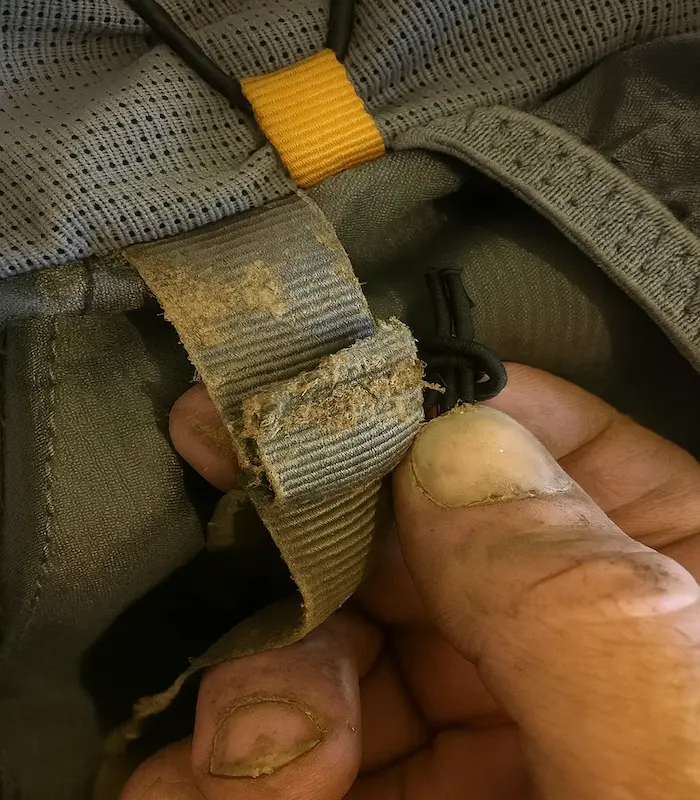On the surface, a strap is just a strap. But for product designers and manufacturers, the material choice for that strap is a critical decision that can determine product success or failure. Using PP webbing where nylon webbing is required can lead to catastrophic failures, negative reviews, and a damaged brand reputation. The consequences are real, and they often start with a simple, cost-cutting mistake.
Let's explore a common scenario and dive deep into the crucial differences in the **nylon vs polypropylene webbing** debate, showing why this understanding is non-negotiable for creating quality products.
The Classic Mistake: PP Webbing on an Outdoor Backpack
Imagine a customer buys a new hiking backpack. It looks great and feels sturdy in the store. The manufacturer, aiming to lower costs, used polypropylene (PP) webbing for its compression straps and gear loops. For the first few uses, everything seems fine.
Then, after a season of use—exposed to sunlight, temperature changes, and abrasion—the straps begin to change. They feel stiff and lose their color. One day, the customer cinches down a strap, and it doesn't just fray; it snaps with a brittle crack. The product has failed, the customer is stranded with broken gear, and a negative online review is almost certain.
This isn't a rare occurrence. It's the predictable outcome of using a material with poor UV resistance in an application that guarantees sun exposure. This is the primary danger of misusing PP webbing, a topic we explore further in our complete guide to PP webbing.
When is PP (Polypropylene) Webbing the Right Choice?
Despite its weakness to sunlight, PP webbing has its place. Its advantages make it ideal for specific, controlled environments:
- Water Resistance: PP is hydrophobic; it doesn't absorb water and it floats. This makes it a great choice for marine applications like boat mooring lines or pool float tethers.
- Low Cost: It is one of the most economical webbing options, suitable for single-use products like disposable medical straps or applications where longevity is not a primary concern.
- Chemical Resistance: It holds up well against most acids and alkalis.
Use PP Webbing for: Marine ropes, disposable medical straps, light-duty bag handles (for indoor use), and other low-stress, low-UV exposure applications.
Nylon Webbing: The Standard for Durability and Strength
Now, let's look at why nylon webbing would have been the correct choice for that backpack. Nylon is a workhorse material, engineered for applications where reliability is paramount, as detailed in our guide to nylon webbing applications.
- Excellent Abrasion Resistance: It can withstand constant rubbing and friction, making it perfect for backpack straps, pet leashes, and tie-downs.
- High Tensile Strength: Nylon is incredibly strong, capable of handling heavy loads, which is essential for safety equipment and cargo control.
- Good UV Resistance: While not immune, it performs significantly better than PP under sunlight, maintaining its integrity for much longer in outdoor applications. For more on this, see our guide to color fastness.
- Shock Absorption: Nylon has a slight stretch, allowing it to absorb sudden shocks, a valuable trait in recovery straps and safety lanyards.
Use Nylon Webbing for: Outdoor backpacks, climbing gear, safety harnesses, pet collars and leashes, military equipment, and heavy-duty cargo straps.
The Consequences of Material Mismatch
Choosing the wrong material goes beyond a single broken product. The ripple effects can severely impact a business:
- Safety Hazards: Using PP webbing in a safety harness or a child's car seat strap would be dangerously negligent. Material failure in these contexts could be fatal.
- Brand Erosion: A reputation for durable goods can be destroyed by a wave of products failing prematurely. In the age of online reviews, news of poor quality spreads fast.
- Financial Loss: The cost of warranty claims, product recalls, and lost future sales will almost always outweigh the initial savings of using a cheaper, inappropriate material.
Making the Right Choice: It's Not Just About Cost
As a webbing manufacturer, we advise our clients to look beyond the price per meter. The critical question is: What is the intended use and environment for the final product?
If you're unsure which material is which, our guide to identifying webbing materials provides simple tests you can perform. But the best way to avoid a costly mistake is to partner with a knowledgeable supplier.
Don't compromise your product's integrity. The right webbing isn't an expense; it's an investment in quality, safety, and your brand's future. Whether you need heavy-duty nylon webbing for rugged gear or cost-effective PP webbing for the right application, our team can guide you.
Ready to ensure your product is built to last? Contact TMG Webbing today for expert advice and material samples to match your exact needs.

